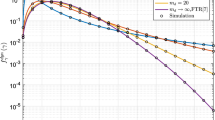Abstract
In this work, we first analyze the accuracy of different energy detector models in approximating the exact solution in AWGN. These models motivate us to develop approximation analysis to address energy detection for fading channels. Our analysis develops approximation that has almost the same performance as the exact solution in Rayleigh channels. Our new model is simple enough to derive the relationship between the required number of samples (N) and the signal-to-noise ratio for a single Rayleigh channel similar to the one obtained for AWGN channels. We also define a fading margin for link budget calculations that relates N in fading channels to AWGN channels. Furthermore, we analyze the impact of multiple antennas for cognitive radios considering two receiver diversity schemes and quantify the improvement in performance regarding this margin. All the analytical results derived in this paper are verified by simulations. Finally, we have implemented and verified energy detection models in our multiple antenna wireless testbed.
Similar content being viewed by others
References
Mitola, J., III. (1999). Cognitive radio for flexible mobile multimedia communication. In Proceedings of IEEE International Workshop on Mobile Multimedia Communications (pp. 3–10).
Mills R. F., Prescott G. E. (1996) A comparison of various radiometer detection models. IEEE Transactions on Aerospace and Electronic Systems 32(1): 467–473
Edell, J. (1976). Wideband, noncoherent, frequency-hopped waveforms and their hybrids in low-probability of intercept communications. Report Naval Research Laboratory (NRL) 8025.
Akyildiz I. F., Lee W. Y., Vuran M. C., Mohanty S. (2006) NeXt generation/dynamic spectrum access/cognitive radio wireless networks: A survey. Computer Networks Journal (Elsevier) 50: 2127–2159
Urkowitz H. (1967) Energy detection of unknown deterministic signals. Proceedings of IEEE 55: 223–231
Digham, F. F., Alouini, M. S. & Simon, M. K. (2003). On the energy detection of unknown signals over fading channels. In Proceedings of IEEE (pp. 3575–3579).
Digham F.F., AlouiniM.S. Simon M.K. (2007) On the energy detection of unknown signals over fading channels. IEEE Transactions on Communications, 55(1): 21–24
Pandharipande, A. & Linnartz, J.-P. M. G. (2007). Performance analysis of primary user detection in a multiple antenna cognitive radio. In IEEE International Conference on Communications (pp. 6482–6486).
Cabric, D., Tkachenko, A. & Brodersen, R. W. (2006). Experimental study of spectrum sensing beased on energy detection and network cooperation. In Proceedings on ACM International workshop on Technology and Policy for Accessing Spectrum.
Nuttall A. H. (1975) Some integrals involving the Q M function. IEEE Transactions on Information Theory 21: 95–96
Torrieri D. J. (1992) Principles of secure communication systems. Artech House, Boston, MA
Kostylev V. I. (2002) Energy detection of a signal with random amplitude. IEEE International Conference on Communications, ICC 2002 3: 1606–1610
Ghasemi, A. & Sousa, E. S. (2005) Colloborative spectrum sensing for opportunistic access in fading environments. In Proceedings of IEEE Dynamic Spectrum Access Networks (pp. 131–136).
Bhattacharya R., Waymire E. C. (2007) A basic course in probability theory. Springer, New York, NY
ChungK.-L. Yan W.-M. (1997) The complex householder transform. IEEE Transactions on Signal Processing, 45(9): 2374–2376
Dohler M., Arndt M. (1997) Inverse incomplete gamma function and its application. IEEE Electronics Letters 42(1): 35–36
Gradshteyn I. S., Ryzhik I. M. (2007) Table of integrals, series, and products. Academic Press, San Diego, CA
Kim, D. & Torlak, M. (2008). Rapid prototyping of a cost effective and flexible 44 MIMO testbed. In Proceedings of IEEE Sensor Array and Multichannel Signal Processing Workshop (pp. 5–8), 21–23 July 2008. Darmstadt, Germany.
Author information
Authors and Affiliations
Corresponding author
Rights and permissions
About this article
Cite this article
Ciftci, S., Torlak, M. A Comparison of Energy Detectability Models for Cognitive Radios in Fading Environments. Wireless Pers Commun 68, 553–574 (2013). https://doi.org/10.1007/s11277-011-0468-3
Published:
Issue Date:
DOI: https://doi.org/10.1007/s11277-011-0468-3




